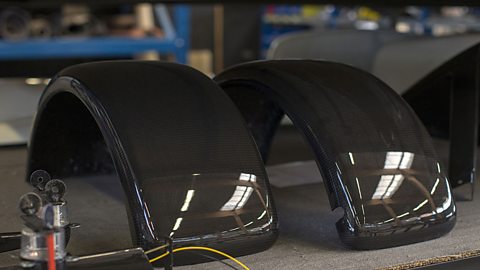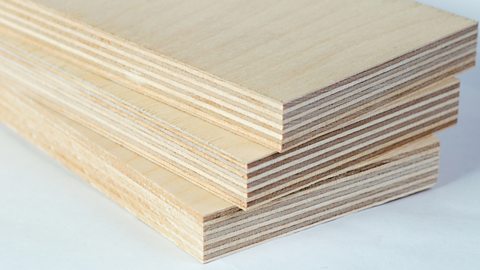Composite materials
compositeBuilt from more than one thing. materials are made up of different materials which are combined to improve their propertiesThe mechanical, physical or optical properties of materials that define how they behave in use.. They can be a combination of naturalSomething that happens in nature and does not need people to make it happen. and syntheticA material made by a chemical process, not naturally occurring. materials but fall into three main categories:
- fibre-based compositeA mixture of two materials - one part is a material in fibre strands and this is made stronger with a resin.
- particle-based compositeA mixture of two materials - one part is small particles, like small balls, and this is made stronger with a liquid that sets
- sheet-based compositeA mixture of two materials - one part is thin sheets of a material and this is made stronger with a resin.
Fibre-based composites
Fibre-based composites are reinforced with fibres. By mixing resinA thermosetting or thermoforming polymer that acts as a glue to hold fibres together. or concrete with fibres of glass or carbon we get the ability to mould complex shapes, but reinforcing them with the fibres makes them very strong.
| Fibre-based composite | Materials | Uses |
| Glass-reinforced plastic (GRP) | Glass fibres and resin | Boats, instrument cases |
| Carbon-reinforced plastic (CRP) | Carbon fibre and resin | Formula 1 car bodies, crash helmets, sports equipment |
| Glass-reinforced concrete (GRC) | Glass fibre and concrete | Street furniture, urban features |
| Fibre-based composite | Glass-reinforced plastic (GRP) |
|---|---|
| Materials | Glass fibres and resin |
| Uses | Boats, instrument cases |
| Fibre-based composite | Carbon-reinforced plastic (CRP) |
|---|---|
| Materials | Carbon fibre and resin |
| Uses | Formula 1 car bodies, crash helmets, sports equipment |
| Fibre-based composite | Glass-reinforced concrete (GRC) |
|---|---|
| Materials | Glass fibre and concrete |
| Uses | Street furniture, urban features |

Image caption, Carbon-reinforced plastic (CRP) in automobile parts
Image caption, Glass-reinforced plastic (GRP) boat hulls
1 of 2
Particle-based composites
Particle-based composites are made with small particles of material. By mixing smaller particles of sand with larger particles of cement and aggregateFragments of rock, stone or small pebbles used to help reinforce concrete., such as stones, we get a very strong and denseCrowded closely together. material suitable for building large structures.
| Particle-based composite | Materials | Uses |
| Concrete | Cement, sand and aggregate | Buildings, street furniture |
| Cermet | Ceramic (cer) and metal (met) | Electronic components that need to operate under very hot temperatures |
| Particle-based composite | Concrete |
|---|---|
| Materials | Cement, sand and aggregate |
| Uses | Buildings, street furniture |
| Particle-based composite | Cermet |
|---|---|
| Materials | Ceramic (cer) and metal (met) |
| Uses | Electronic components that need to operate under very hot temperatures |

Sheet-based composites
Sheet-based composites are often available in large sheets. By mixing wood fibres or thin slices of wood veneerA thin decorative covering of fine wood applied to a coarser wood or other material. with resin it is possible to form large and stable sheets for furniture panels and interior construction.
| Sheet-based composite | Materials | Uses |
| Medium-density fibreboard (MDF) | Wood pulp and resin | Furniture and interior cladding |
| Plywood | Wood veneers and resin | Furniture and construction |
| Chipboard | Wood chip and resin | Furniture panels and construction |
| Sheet-based composite | Medium-density fibreboard (MDF) |
|---|---|
| Materials | Wood pulp and resin |
| Uses | Furniture and interior cladding |
| Sheet-based composite | Plywood |
|---|---|
| Materials | Wood veneers and resin |
| Uses | Furniture and construction |
| Sheet-based composite | Chipboard |
|---|---|
| Materials | Wood chip and resin |
| Uses | Furniture panels and construction |

Like all modern materials, composites are engineered to improve their properties. There are many more combinations of materials that are designed to meet a particular need or purpose. For example, wood has been reinforced with strips of carbon to make a wooden bicycle frame.
Often the original material has a useful feature, the ability to be formed or a certain appearance, but lacks strength or durabilityThe ability of a material to withstand wear, especially as a result of weathering.. In this case different material combinations can solve the problem and new composites are being developed all the time.
geotextileA textile fabric used to improve drainage where soil and rock materials may cause water to sit on the surface. are materials used in contact with or within soil to improve construction and long-term performance. They are used in civil construction, coastal engineering and especially in roads to improve soil characteristics and make it stronger. Geotextiles can make poor soil more manageable so that it is possible to build in places which would otherwise prove difficult.
